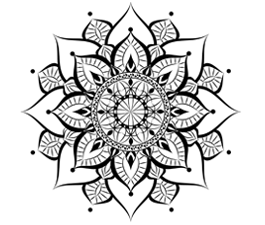People have worshipped the great feminine for a very long time. These goddesses and mystical feminine archetypes appear in Vedic and Tantric teachings, as you would expect. The reason why I’ve started writing about Hindu Goddess Kālī is because of the misconception that she is the ‘one with garland of skulls’ and misunderstanding that she is the ‘the dark one’.
She is of course depicted with garland of skulls and is a bit darker in colour (she’s blue). But, she is also very misunderstood and for me, she is actually quite a positive goddess; one very close to female change and menopause.
Kālī , is one of the ten Dash Mahavidyas (ten different approaches to knowledge), considered as the goddess of death, dark mind and destruction in the eyes of many people. She has a fearsome reputation as the destroyer of demons. And in Hinduism and Vedas, Kālī is the black Goddess of Doomsday, Time and Death. But Kālī has many positive aspects too. While Kālī was introduced into the Vedic Hindu tradition, she was also developing a parallel line (or life) in the Tantric traditions.
Sanskrit word kala means both ‘death’ and ‘time’. Everything in this world is time-bound. ‘When a being’s time is over, its shakti is gone and the being is dead.’[i] In other words, death is the end of the energy (prana) in time of the life. Whilst matter is considered as neither created nor destroyed, it only changes form. Here Kālī is the transformation which often happens from inside and may not always be visible from the outside. She is depicted as a voluptuous, motherly, young and beautiful, with gentle smile, attractive ornaments and pleasing blue complexion. This transformation is often seen as a birth of something else, something deeper. In Tantra, Kālī is considered as a positive goddess, and is called Kālī Ma (Ma meaning Mother in Sanskrit) or Divine Mother and is a symbol of Mother Nature herself. She is primordial, creative, nurturing and devouring, but ultimately loving and benevolent. Many millions of Hindus worship her in this form. In Tantric meditation, Kālī’s dual nature instructs practitioners to simultaneously face the beauty of life and the reality of death. One cannot exist without the other. In this aspect, she is considered to stand outside of the constraints of space-time and have no permanent qualities; she existed before the universe was created and will continue to exist after the universe ends.
In Yoga, attachment is one of the ‘avidyas’ (ignorances). Attachment to the material form (the physical body) causes fear of death. This is the basic fear rooted deep in us all. But Kālī can remove this fear of death – the basic insecurity of the Muladhara chakra. Kālī is the mahavidya that removes the ‘avidya’ (ignorance).
The transformation of Kali Ma is also shown through creativity, and undoubtedly, in the female empowerment that comes with menopause and golden age. Just as the limitations of the physical world do not apply to Kālī in the Tantric traditions, such as colour, light, good and bad so do the physical limitations do not apply in the female empowerment and the menopause.
Of course, in the 20th and 21st centuries, many western feminist scholars have adopted Kālī as a mascot of female empowerment, or have politicised her as a symbol of the supposed former matriarchal golden age that came before patriarchal control and decline.
One of the aspects of Kālī’s visions is liberation (one of the images depicting Kālī is the goddess dancing/standing on Shiva). And this could be the synonym for many menopausal women who have entered the golden age. The liberation of Ego and the detachment from the physical limitations. And this is the destruction of negative ego. Hence, leading to female empowerment. But also, unpredictability.
However, the real essence of Kālī is the destroyer of negative ego. She is the warrior, Mother who thinks only of the welfare of her children ‘Kali’s devotees…experience her as a loving, nurturing and protecting mother. With tear-filled eyes and a longing heart, they invoke her as Kali Ma, asking for health, wealth and happiness as well as liberation. Like a doting mother, she bestows all boons upon her human children…’[ii]
The sword that Kālī holds in her hand symbolises higher knowledge, the severed head that she holds in the other hand is the human ego that must be severed in order to exit from the cycle of life and rebirth. Kālī is wisdom and power. One more reason why I associate with her – because of this power that comes with acceptance of change and the willingness to let go in order to grow and carry on. This power comes with every change in the female lives. Kali helps us drop the limitations of who we think we are in order to encounter the next stage in life and potential of what we can become. ‘Kali invites us to surrender completely any ideas that come from a desire to fix or define our sense of identity. To access our unlimited powers requires that we allow a part of us to die, and accept the change (the change of becoming grey and not wishing to dye my hair for example). Kali’s power is so immense that if we choose not to engage, she will get us through it but with grief and regret.
So Kālī, the goddess of time and death is actually the powerful goddess of wisdom and knowledge.
Jai Kali Ma!
[i] Tools for Tantra, Harish Johari
[ii] George Fuerstein ‘Tantra: Path of Ecstasy’
Further References:
Yoni Shakti by Uma Dinsmore-Tuli
Shakti Mantras, Tapping into the Great Goddess Energy Within by Thomas Ashley-Farrand



Leave A Comment